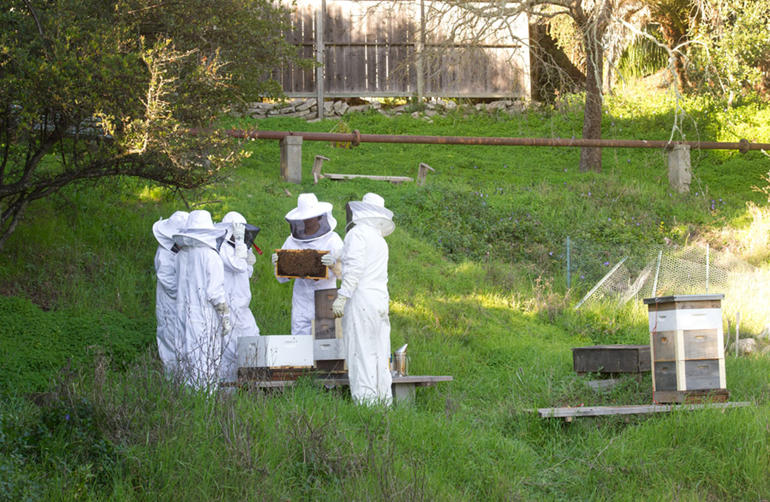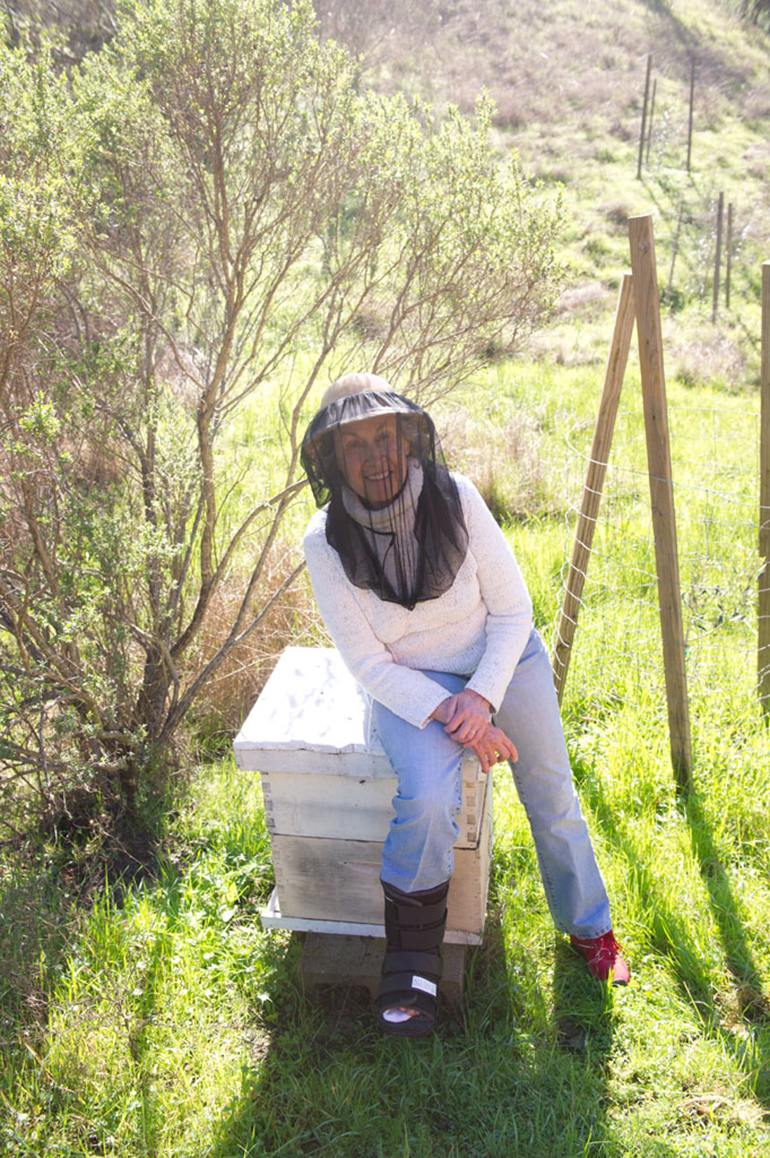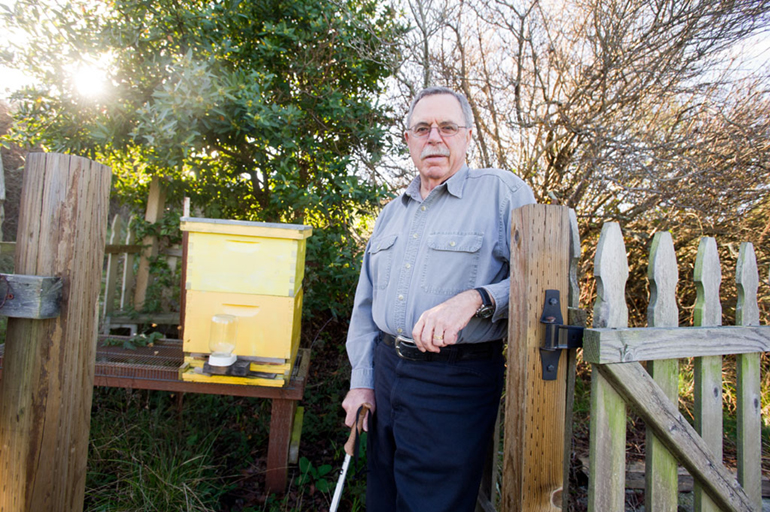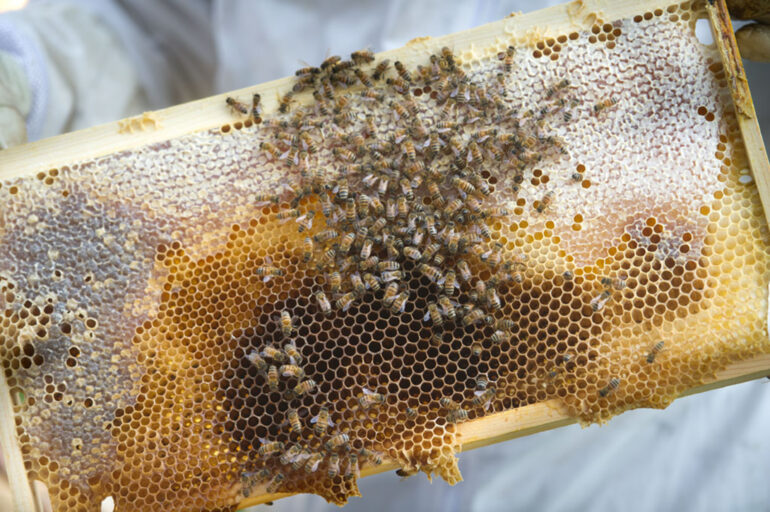Beekeepers share more in common than veiled suits and a predilection for raw honey. They tend to be passionate and have a strong sense of priorities. And so they gathered, 40-or-so souls, in the American Legion Log Cabin in San Anselmo on the evening of Oct. 7, 2010. Given the choice between watching Giants ace Tim Lincecum take the mound against Atlanta in the first game of the National League Division Series, or hearing a talk by renowned bee expert Diana Sammataro, Ph.D., they opted for apiculture.
The Freak struck out 14 in a two-hit shutout, and the bee people were OK with that. Because some of them taped the game. And because Sammataro, coauthor of the The Beekeeper’s Handbook, spent the evening holding forth on a subject that was really important to them. The beekeepers, you see, are doing more than sharing their mutual interest in pollination, bee breeding and harvesting honey. They’re saving the world.
Their quest may not be as overtly dramatic as, say, Wolverine and Rogue vs. the Brotherhood of Mutant Ninjas in X-Men, but to hear some tell it the stakes are just as high. Since 2006, according to the U.S. Department of Agriculture, beekeepers have reported the losses of 30 to 90 percent of their hives—a mysterious global phenomenon known as Colony Collapse Disorder. While such losses are upsetting for small-scale beekeepers like those in the Log Cabin, they are catastrophic for commercial beekeepers, who own up to 50,000 colonies and truck them around the country on flatbeds carrying as many as 500 hives apiece. Farmers rely on these itinerant bees to pollinate almonds, apples, avocados, cantaloupes, kiwis, cucumbers and many more flowering crops. If bees don’t pollinate, we don’t eat. Pretty simple. A Cornell University study estimated that bees annually pollinate more than $14 billion worth of seeds and crops in the United States—every third bite of food we put in our mouths. When those industrious little laborers start disappearing, Big Ag takes notice.

So, too, do Marin’s beekeepers, whose number has been expanding logarithmically. Membership in the Marin County Beekeepers has gone from roughly a dozen a few years ago, says Mea McNeil-Draper, a longstanding member of the club, to in the neighborhood of 200 today.
The couple lives on a small, organic farm at the foot of Sorich Park in San Anselmo. They’ve kept bees for three decades. Mea, author of numerous articles for the venerable American Bee Journal, describes the avocation as resting “on the synapse between human life and the natural world. When you keep bees, you become much more aware—aware of the cycle of the seasons, of what’s in bloom, of the kinds of flowers on which bees can forage.”
Beekeeping Basics
Maria Bennett of San Anselmo is a talented, passionate gardener. Her husband, Patrick, is … less so. Several years ago, on the advice of his friend, the late Bill Patterson, and in order to “play alongside Maria” in the backyard, he took up beekeeping, which delighted him in unexpected ways. “You walk out of your house on a sunny day, and there’s all this … activity. The foragers are foraging, the guard bees are watching the entrance—everyone’s doing their thing. You get a sense that they’re happy, which makes me happy.”
Less happy-making was his first attempt to harvest honey, which devolved into a “Lucille Ball debacle,” Bennett says. “There was honey on every surface of the kitchen—plus all this wax on the floor that turned black. It was like a honey-bomb exploded. To this day, if Maria feels something on the counter and she’s not sure what it is, she’ll say, ‘I think that’s your honey.’”
Bennett urges beginning beekeepers to take a class on the subject to avoid duplicating his prolonged learning curve. In complete agreement is Charles Gompertz, a Nicasio rancher and Episcopal priest whose bees deserted him for an entire year before he and his wife enrolled in a class, after which he recalls saying, “Oh my God, we’ve been doing everything wrong!”
Gompertz still winces at the memory of the time he was unable to dislodge some 50 bees from a plastic cassette containing honeycomb. He had the bright idea to put the cassette in the freezer for three days. Upon taking it outside and giving it several robust whacks, he was dismayed to learn that the bees were not dead, merely … very lethargic. But they awakened quickly. “Man, were they pissed,” he says. “They were not happy, and they knew it was my fault.” He was stung all over his face and hands.

Trying to Smite the Mite
Bee life in North America collapsed in the mid-80s, following the introduction of an Asian mite since dubbed the Varroa Destructor that swept across the continent. “Losses were as high as 90 percent,” says McNeil-Draper, who recalls that large-scale beekeepers found themselves at “a fork in the road.” They could ride out the storm by breeding a strain of honeybee resistant to the mite. Or they could treat their surviving bees—and fight the mite—with chemicals.
Chemicals won. Since then, beekeepers have battled the V. Destructor with a series of increasingly stronger miticides. “The industry has gotten onto a chemical treadmill,” says McNeil-Draper. In so doing, it has succeeded only in “breeding a supermite” that wreaks havoc on the broods of both large-scale and backyard beekeepers.
The Asian mite, it turns out, is but one of the parasites, viruses and chemicals stressing the bees. Another culprit: commercial beekeeping itself. Not surprisingly, trucking bees all over the country isn’t good for the bees. Nor is their “monoculture” diet—the food they eat while pollinating vast acreages of one crop. “It would be like you and I could eat only French fries,” says McNeil-Draper.
How to reverse the decline? The EPA could help by revisiting its decision to allow farmers to use the pesticide clothianidin—described in a recently leaked agency report as carrying “a major risk … to nontarget insects (that is, honeybees).” (Manufactured by German agrochemical giant Bayer, clothianidin use is banned in that country.)
More encouraging is a grass-roots movement toward organic practices. Some keepers, instead of treating their hives with chemicals, are breeding bees resistant to natural enemies. The downside: until they find the right strain of so-called “survivor stock,” they lose a lot of bees. When a colony collapses or disappears, it’s roughly $100 to start over. “Compared to, say, ripping a sail, or replacing the wheels on your road bike, that’s not a huge hit,” says Bennett. But it tests a beekeeper’s allegiance to organic practices. Even so, the movement toward survivor stock is going strong in “small pockets” of the country, according to McNeil-Draper, and nowhere more so than in Marin.
In making the case that this is the best way forward, McNeil-Draper is persuasive, but not strident. “You put out what you learn, you explain what you know, and people have to come to their own decisions,” she says. She quoted a bee researcher who was also an aikido black belt, and who put it this way: “The mountain has to move itself.”

The Buzz on Campus
“This used to be a maintenance yard,” says Paul Poutiatine, guiding a visitor down a path behind Marin Academy. To the right is a fair-size compost pile, abutting an elaborate, fenced garden featuring fruit trees and winter greens. To the left, cordoned off with rope, is the school’s modest apiary: two hives bookending a wooden bench that, until recently, was the home of a third hive. That colony succumbed to a malady called American Foulbrood Disease.
“The big thing about beekeeping,” says Poutiatine, “is getting them through the winter.” In addition to teaching English, he is the school’s outings director and the leader of its beekeeping club. The first of the school’s two surviving hives is thronged with bees and clearly thriving. Poutiatine estimates its population at 25,000, and growing.
The second hive has far less traffic. It is home to five or six thousand bees—“just on the edge of viability,” says Poutiatine, who isn’t sure why one hive prospered during a winter while its neighbor struggled. “It was hit harder by the stresses” to which all colonies are subjected: mites, viruses, cold and lack of food, or “nectar flow,” as bee people call it.
Students join the club for various reasons. The honey is a lure. “There’s something mysterious, esoteric about it,” says Poutiatine. “If you can keep bees, you’re somehow a little bit magical. Not everyone falls in love with the compost pile, but the bees have a broader appeal.”
What seep in, almost by osmosis, are lessons in sustainability. When students see a hive struggling, he says, “they start asking questions: Should we switch brood chambers? Should we use plastic comb or natural comb?”
As Poutiatine led a group of new, bee-suited club members out to the smaller of the two hives, he cautioned, “Be on guard, but don’t act as if you’re on guard, because you’ll make the bees nervous.”

There weren’t many signs of life in the hive’s top compartment, the so-called “honey super.” But as the students pulled frames from the “upper brood box,” one story below, Poutiatine could not hide his excitement. “Does that feel heavy? It’s full of honey. Wow. That’s probably eight pounds. One frame! That’s what capped honey looks like.”
The news only got better. The next frame that came out was covered with bees, some of them brand new. “This is capped brood,” explained the teacher. “It’s a small patch, but it’s a great pattern, it’s a dense pattern. That’s good. That bee with the white fur is brand new. These bees will all live about six weeks.”
“Look—eggs!” exclaimed Poutiatine, inspecting another frame. “Cool! So there is a queen in here and she’s laying eggs.”
The excitement in his voice, the periodic questions of the students, and the low but discernible hum of the hive, all added up to a hopeful sound—the sound of the mountain moving itself.
This article originally appeared in Marin Magazine’s March 2011 print edition under the headline: “Beekeeping 101.”


